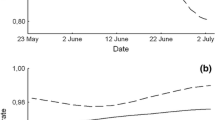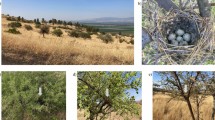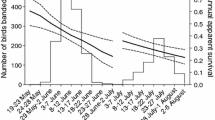Abstract
Several hypotheses have been proposed in the literature to account for the different responses birds show to varying degrees of nest predation. These are discussed using data on Marsh and Reed Warbler (Acrocephalus palustris, A. scirpaceus) which differ greatly in nest predation even when they share the same habitat. Breeding success was distinctly higher in Marsh than in Reed Warblers per breeding attempt (averaging 68.1% and 44.9% respectively). Different levels of egg predation and Cuckoo (Cuculus canorus) parasitism were the main reasons. During an egg laying period of about 14 weeks Reed Warblers produce many replacement clutches and second broods resulting in an average annual reproductive output of 3.8 fledged young per female. The single brooded Marsh Warbler with a laying period of 7 weeks produces 3.3 fledglings. Differences in structure and seasonality of the species' respective habitats, i. e. reedbeds in Reed Warbler and herbaceous vegetation in Marsh Warbler, contribute to the differences in breeding success and the length of breeding periods open to the two species. Marsh Warblers respond to limited breeding opportunities due to their narrow breeding season with higher clutch size, and by avoiding nest losses. They conceal nests better, breed in lower densities, and efficiently reject Cuckoo eggs. Ecological constraints may restrain the Reed Warbler to its comparably unsafe nest sites. In other open-nesting and ecologically similar species pairs, a similar higher breeding success also occurs in those species that stay for a shorter period on the breeding grounds. It appears that high breeding success is an important prerequisite for species breeding in ephemeral habitats.
Zusammenfassung
Eine Analyse des Bruterfolges anhand 20 brutbiologischer Studien am Teich- und 9 Studien am Sumpfrohrsänger (Acrocephalus scirpaceus, A. palustris) zeigt große Unterschiede zwischen beiden Arten, selbst wenn sie nebeneinander im selben Habitat nisten. Der Bruterfolg pro Brutversuch (Zahl ausgeflogener Junge/Zahl gelegter Eier) war mit durchschnittlich 68,1% beim Sumpfrohrsänger deutlich höher als beim Teichrohrsänger mit nur 44,9% (Tab. 1). Die Prädation von Eiern sowie Parasitierung durch den Kuckuck (Cuculus canorus) sind beim Teichrohrsänger deutlich höher und wichtigste Erklärung für die Unterschiede im Bruterfolg (Tab. 2). Während einer Legeperiode von insgesamt ca. 14 Wochen können Teichrohrsänger jedoch Brutverluste durch zahlreiche Nachgelege kompensieren und darüberhinaus noch Zweitbruten produzieren. Deshalb beträgt ihr jährlicher Gesamtbruterfolg durchschnittlich 3,8 flügge Junge pro Weibchen. Sumpfrohrsänger dagegen ziehen obligatorisch nur 1 Brut pro Jahr auf und haben eine Legeperiode von nur 7 Wochen. Ihr Gesamtbruterfolg beträgt ca. 3,3 flügge Junge pro Weibchen und ist nicht mehr wesentlich vom entsprechenden Wert für Teichrohrsänger verschieden. Unterschiede in der Struktur des Lebensraumes, beim Teichrohrsänger Schilfröhrichte mit stabilerem (und damit länger zum Nisten zur Verfügung stehendem) Aufwuchs bzw. beim Sumpfrohrsänger eine eher instabile und saisonal nur kurzzeitig zum Nisten geeignete Krautvegetation (die im Lauf des Sommers bereits zu welken beginnt), vermögen großenteils die Unterschiede im Bruterfolg beider Rohrsänger sowie in der Länge ihrer Legeperioden erklären. Die nur kurze Legeperiode des Sumpfrohrsängers bietet auch nur begrenzte Möglichkeiten zum erfolgreichen Brüten („limited breeding opportunities”-Hypothese;Martin 1992). Seine höhere durchschnittliche Gelegegröße und die stärkere Vermeidung von Brutverlusten dienen als Kompensationsmechanismen hierfür. So tarnen Sumpfrohrsänger ihre Nester besser, brüten in geringerer Dichte und entfernen Kuckuckseier effektiver als Teichrohrsänger. Ökologische Zwänge scheinen dafür verantwortlich zu sein, daß Teichrohrsänger an Röhrichte und die dort stärker gefährdeten Neststandorte gebunden bleiben. Der Vergleich weiterer freibrütender Artenpaare mit einander ähnlichen ökologischen Ansprüchen bestätigt, daß diejenige Art, die kürzer am Brutplatz verweilt, jeweils den höheren durchschnittlichen Bruterfolg aufweist (Tab. 3). Offensichtlich ist hoher Bruterfolg wichtige Voraussetzung dafür, daß einige Arten in ephemeren, nur kurzfristig zur Verfügung stehenden Habitaten (Vegetationstypen) überhaupt brüten können.
Similar content being viewed by others
Literature
Beier, J. (1981): Untersuchungen an Drossel- und Teichrohrsängern (Acrocephalus arundinaceus, A. scirpaceus): Bestandsentwicklung, Brutbiologie, Ökologie. J. Orn. 122: 209–230.
Berthold, P., G. Fliege, G. Heine, U. Querner &R. Schlenker (1991) Autum migration, resting behaviour, biometry and moult of small birds in Central Europe. Vogelwarte 36: 1–221.
Bibby, C. J. (1978): Some breeding statistics of reed and sedge warblers. Bird Study, 25: 207–222.
Ditto &D. K. Thomas (1985): Breeding and diets of the Reed Warbler in a rich and a poor site. Bird Study 32: 19–31.
Borowiec, M. (1992): Breeding ethology and ecology of the Reed Warbler,Acrocephalus scirpaceus (Hermann, 1804) at Milicz, SW Poland. Acta Zool. cracov. 35: 315–350.
Brown, P. R. &M. G. Davies (1949) Reed Warblers. Foy, East Molesey, Surrey.
Catchpole, C. K. (1974): Habitat selection and breeding success in the Reed Warbler (Acrocephalus scirpaceus). J. Anim. Ecol. 43: 363–380.
Davies, N. B., &M. de L. Brooke (1988): Cuckoos versus Reed Warblers: adaptations and counteradaptations. Anim. Behav. 36: 262–284.
Ditto, &R. E. Green (1976): The development and ecological significance of feeding techniques in the Reed Warbler. Anim. Behav. 24: 213–229.
Dorsch, H. &I. Dorsch (1985): Dynamik und Ökologie der Sommervogelgemeinschaft einer Verlandungszone bei Leipzig. Beitr. Vogelkde. 31: 237–358.
Dowsett-Lemaire, F. (1981): Eco-ethological aspects of breeding in the Marsch Warbler,Acrocephalus palustris. Terre et Vie 35: 437–491.
Ditto &R. J. Dowsett (1987): European Reed and Marsh Warblers in Africa: Migration patterns, moult and habitat. Ostrich 58: 65–85.
Dyrcz, A. (1981): Breeding ecology of great Reed Warbler (Acrocephalus arundinaceus) and Reed Warbler (A. scirpaceus) at fish ponds in SW-Poland and lakes in NW-Switzerland. Acta orn. 18: 307–333.
Erlinger, G. (1988): Die Rohrsänger der Hagenauer Bucht. Teil 2: Der Teichrohrsänger. Öko-L 8: 19–24.
Francçois, J. (1985): Contribution a l'écologie d'une population des Rousserolles verderolles dans le Jura francais. These Fac. Sci. Tech. Franche-Compte, Besancon.
Franz, D. 1981): Ergebnisse einer Populationsuntersuchung am Sumpfrohrsänger (Acrocephalus palustris). Anz. orn. Ges. Bayern 20: 105–126.
Gärtner, K. (1982): Zur Ablehnung von Eiern und Jungen des Kuckuck (Cuculus canorus) durch die Wirtsvögel-Beobachtungen und experimentelle Untersuchungen am Sumpfrohrsänger (Acrocephalus palustris). Vogelwelt 103: 201–224.
Glutz von Blotzheim, U. N., &K. M. Bauer (1985, 1988, 1991): Handbuch der Vögel Mitteleuropas. Vol. 10, 11, 12. Wiesbaden.
Greenberg, R. (1980): Demographic aspects of long-distance migration. In:Keast, A., E. S. Morton, Migrant birds in the Neotropics: 493–504. Washington D. C.
Havlin, J. (1971): Nesting biology of the Great Reed and Reed Warbler on the Namestske rybniky ponds. Zool. Listy 20: 51–68.
Henriksen, K. (1992): Breeding of Reed Warblers in small reed beds. Dansk Orn. foren. Tidskr. 86: 263–266.
Hoi, H., &H. Winkler (1988): Feinddruck auf Schilfbrüter: Eine experimentelle Untersuchung. J. Orn. 129: 439–447.
Hund, K. &R. Mörike (1993): Brutbiologische und ethologische Untersuchungen an einer Brutpopulation des Teichrohrsängers im Pfrunger Ried/Obserschwaben. Beih. Veröff. Natursch. Landschaftspfl. Baden-Württemberg 68: 97–127.
Hut, van der, R. M. G. (1986): Habitat choice and temporal differention in reed passerines of a Dutch marsh. Ardea 74: 159–176.
Kelsey, M. G. (1989): Breeding biology of Marsh WarblersAcrocephalus palustris in Worcestershire: a comparison with European populations. Bird Study 36: 205–210.
Kipp, F. (1943): Beziehungen zwischen dem Zug und der Brutbiologie der Vögel. J. Orn. 91: 144–153.
Lack, D. (1948): The significance of clutch size. Part 3. Some interspecific comparisons. Ibis 90: 25–45.
Ditto (1954): The natural regulation of animal numbers. Oxford.
Leisler, B. (1980): Morphological aspects of ecological specialisation in bird genera. Ökol. Vögel 2: 199–220.
Ditto (1981): Die ökologische Einnischung der mitteleuropäischen Rohrsänger (Acrocephalus, Sylviinae). I. Habitattrennung. Vogelwarte 31: 45–74.
Ditto (1988): Interspecific interactions among European marsh-nesting passerines. Acta XIX Congr. Int. Orn. Ottawa 1986: 2635–2644.
Ditto &C. K. Catchpole (1992): The evolution of polygamy in European Reed Warblers of the genusAcrocephalus: a comparative approach. Ethol. Ecol. & Evol. 4: 225–243.
Ditto,H. W. Ley &H. Winkler (1989): Habitat, behaviour and morphology ofAcrocephalus warblers: an integrated analysis. Orn Scand 20: 181–186.
Lemaire, F. (1977): Mixed song, interspecific competition and hybridisation in the Reed and Marsh Warblers. Behaviour 63: 215–240.
Marchetti, K. (1992): Costs to host defence and persistence of parasitic cuckoos. Proc. R. Soc. Lond. B 248: 41–45.
Martin, T. E. (1988a): Habitat and area effects on forest bird assemblages: is nest predation an influence? Ecology 69: 74–84.
Ditto (1988b): Nest placement: Implications for selected lige-history traits, with special reference to clutch size. Am. Nat. 132: 900–910.
Ditto (1992): Interaction of nest predation and food limitations in reproductive strategies. Current Ornithol. 9: 163–197.
Ditto (1993): Nest predation and nest sites. New perspectives on old patterns. BioSciene 43: 523–532.
Mayfield, H. (1975): Suggestions for calculating nest success. Wilson Bull. 87: 456–466.
Milsom, T. P. (1982): Edge effect on breeding Reed Warblers in North Humberside. Bird Study 29: 167–168.
Naylor, A. K., &R. E. Green (1976): Timing of fledging and passage of Reed Warblers. Wicken Fen Group Rep. 8: 15–18.
Neudorf, D. L., &S. G. Sealy (1992): Reactions of four passerine species to threats of predation and cowbird parasitism: Enemy recognition or generalized responses? Behaviour 123: 84–105.
Nilsson, L., &H. Persson (1986): Boplatsval, kullstorlek och häckningsframgang hos en skansk rorsangarpopulation. Var. Fagelv. 45: 340–346.
Ölschlegel, H. (1981): Ergebnisse zehnjähriger Beobachtungen an einer Population des TeichrohrsängersAcrocephalus scirpaceus. Beitr. Vogelkde. 27: 329–362.
Pearson, D. J., &P. C. Lack (1992): Migration patterns and habitat use by passerine and near-passerine migrant birds in eastern Africa. Ibis 134, Suppl. 1: 89–98.
Petrie, M., &A. P. Møller (1991): Laying eggs in others nests: Intraspecific brood parasitism in birds. Trends Ecol. Evol. 6: 315–320.
Petrik, F. (1983): Breeding biology of the Marsh Warbler (Acrocephalus palustris) in the pond areas of the Ostrava basin. Folia Zool. 32: 137–143.
Picman, J., M. L. Milks &M. Leptich (1993): Patterns of predation on passerine nests in marshes: Effect of water depth and distance from edge. Auk 110: 89–94.
Post, W. (1988): Reproductive success in New World marsh-nesting passerines. Acta XIX Congr. Int. Orn. Ottawa 1986: 2645–2657.
Pukas, A. (1989): The cases of mixed pairs of Reed and Marsh Warblers. Zool. Zh. 68: 112–115.
Ricklefs, R. E. (1969): An analysis of nesting mortality in birds. Smithsonian Contr. Zool. 9: 1–48.
Ditto (1989): Nest predation and the species diversity of birds. Trends Ecol. Evol. 4: 184–186.
Rothstein, S. I. (1990): A model system for coevolution: avian brood parasitism. Ann. Rev. Ecol. Syst. 21: 481–508.
Saino, N. (1989): Breeding microhabitats of three sympatricAcrocephalinae species (aves) in northwestern Italy. Boll. Zool. 56: 47–54.
Schön, M. (1994): Verhaltensbiologie und Lebensraum des Raubwürgers (Lanius excubitor). Diss. Univ. Tübingen.
Schulze-Hagen, K. (1983): Der Bruterfolg beim Sumpfrohrsänger (Acrocephalus palustris). Charadrius 19: 36–45.
Ditto (1984): Bruterfolg des Sumpfrohrsängers in Abhängigkeit von der Nistplatzwahl. J. Orn. 125: 201–208.
Ditto (1991 a):Acrocephalus palustris — Sumpfrohrsänger. In:Glutz von Blotzheim, U. N., &K. M. Bauer, Handbuch der Vögel Mitteleuropas. Vol. 12: 377–433. Wiesbaden.
Ditto (1991 b):Acrocephalus scirpaceus — Teichrohrsänger. In:Glutz von Blotzheim, U. N. &K. M. Bauer, Handbuch der Vögel Mitteleuropas, Vol. 12: 433–486. Wiesbaden.
Ditto (1992): Parasitierung und Brutverluste durch den Kuckuck bei Teich- und Sumpfrohrsänger in Mittel- und Westeuropa. J. Orn. 133: 237–249.
Ditto,B. Leisler &H. Winkler (1992): Teich- und Sumpfrohrsänger in gemeinsamem Habitat: Brutzeit und Bruterfolg. Vogelwelt 113: 89–98.
Ditto &W. Mädlow (1986): Brutstatistik des SumpfrohrsängersAcrocephalus palustris bei wirtschaftlicher Nutzung des Habitats. Orn. Ber. Berlin (West) 11: 19–26.
Ditto &G. Sennert (1990a): Teich-und Sumpfrohrsänger in gemeinsamem Habitat: Zeitliche und räumliche Trennung. Vogelwarte 35: 215–230.
Ditto (1990b): Nestverteidigung bei Teich- und Sumpfrohrsänger — Ein Vergleich. Ökol. Vögel 12: 1–11.
Slavold, T. (1982): Clutch size variation in passerine birds: the nest predation hypothesis. Oecologia 54: 159–169.
Taillandier, J. (1990): Premieres données sur la dynamique d'une population de rousserolle effarvatte (Acrocephalus scirpaceus) en marais salant de Guerande (Loire—Atlantique). Alauda 58: 21–28.
Thielemann, A. (1965): Quantitative Erfassungen einer Teichrohrsänger-Population. Natur und Heimat 25: 89–91.
Warden, D. (1984): Reed Warblers at Chew Valley Lake, Avon. Bristol Orn. 17: 73–76.
Westphal, D. (1980): Bestandsentwicklung und Brutbiologie des Teich- und Drosselrohrsängers (Acrocephalis scripaceus undarundinaceus) an der Berliner Havel. Orn. Ber. Berlin (West) 5: 3–36.
Wiprächtiger, P. (1976): Beitrag zur Brutbiologie des Sumpfrohrsängers (Acrocephalus palustris). Orn. Beob. 73: 11–25.
Wyllie, I. (1981): The Cuckoo. London.
Author information
Authors and Affiliations
Rights and permissions
About this article
Cite this article
Schulze-Hagen, K., Leisler, B. & Winkler, H. Breeding success and reproductive strategies of twoAcrocephalus warblers. J Ornithol 137, 181–192 (1996). https://doi.org/10.1007/BF01653633
Published:
Issue Date:
DOI: https://doi.org/10.1007/BF01653633




